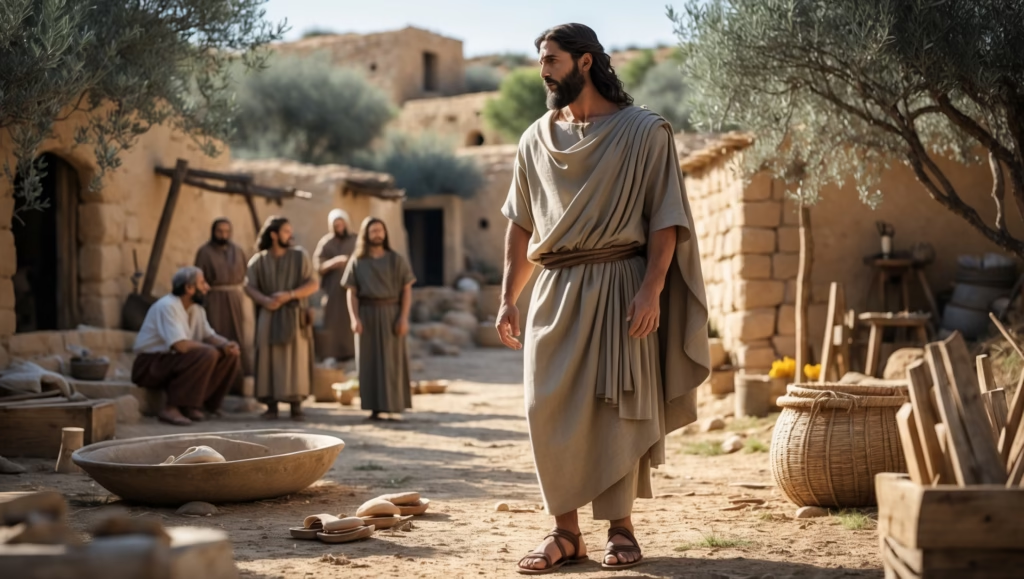Understanding Jesus Through Garments
When we study Jesus, we often focus on His teachings, miracles, and parables—but the material culture surrounding Him also offers insight into His ministry. Clothing in first-century Judea was not only practical; it conveyed social status, religious identity, and cultural values. From the seamless tunic gambled for at His crucifixion to the humble tunics He wore while teaching, Jesus’ attire reflected His message of accessibility, humility, and theological symbolism.
Textile analysis allows historians, archaeologists, and theologians to reconstruct what a Galilean rabbi might have worn, how those garments differed from Pharisaic elites, and how clothing intersected with the narratives of His life and death.

The Seamless Tunic: Symbolism at the Cross
John 19:23–24 describes Roman soldiers casting lots for Jesus’ seamless tunic after His crucifixion. This detail is significant for several reasons:
- Craftsmanship
Seamless garments were typically woven as a single piece, requiring skilled artisanship. Unlike patched or pieced clothing, a seamless tunic indicated quality and care, though Jesus wore it in poverty. - Symbolic Meaning
The seamless tunic became a theological metaphor. Early Church Fathers interpreted it as representing Christ’s unity and perfection. In liturgical art, it is often shown as white or undyed, emphasizing purity and holiness. - Cultural Context
Seamless garments were unusual among commoners, who typically wore patched wool or linen tunics. The soldiers’ decision to gamble for it shows both the practicality and the symbolic value perceived in Roman eyes.
Comparing Jesus’ Attire to Pharisaic Dress
Jesus’ clothing contrasted with the elaborate garments of religious elites:
- Fringes and Tassels (Matthew 23:5)
Pharisees adorned themselves with tassels (tzitzit) to signify piety and adherence to the Law. Their clothing displayed social status and religious performance. - Jesus’ Simplicity
In contrast, Jesus’ tunics were plain, functional, and free of ostentation. This mirrored His broader rejection of performative religiosity, emphasizing inner righteousness over outward display. - Practicality and Mobility
As a teacher, healer, and traveler, His attire needed to support long journeys, labor in carpentry, and ministry in towns and villages. Lightweight linen or wool tunics allowed for freedom of movement, reflecting a life of service and accessibility.
Materials, Weaving, and Regional Styles
- Textiles
- Wool: Common among Galilean villagers; durable and warm.
- Linen: Lighter and used for undergarments or sacred rites.
- Dyes: Mostly natural plant or insect dyes; brighter colors often indicated wealth.
- Weaving Techniques
- First-century textiles used simple two-thread weave structures.
- Seamless tunics were more complex, requiring continuous looms or sophisticated hand weaving.
- Regional Variation
Galilean tunics differed slightly from Judean city clothing. Villagers favored rougher textures, muted colors, and practical lengths, while urban elites had access to finer fabrics and decorative embroidery.
Modern Attempts to Recreate Biblical Garments
Scholars, theologians, and filmmakers have sought to recreate authentic 1st-century clothing to better understand Jesus’ world:
- Museum Exhibits
Institutions like the Israel Museum and the Biblical Archaeology Society display replicas of tunics, sandals, and head coverings. - Film and Theater
Movies and stage productions attempt historically accurate garments, balancing visual storytelling with archaeological evidence. - Faith-Based Workshops
Some religious organizations produce handwoven tunics to educate communities about daily life in first-century Judea.
These recreations highlight not just fabric and stitching but also the lived experience of Jesus and His contemporaries, giving modern audiences tactile insight into ancient culture.
Theological and Cultural Implications
Jesus’ clothing was more than mere attire; it communicated humility, approachability, and theological meaning:
- Embodied Ministry
His garments allowed Him to engage physically with those He healed, taught, and comforted. - Symbol of Humility
Unlike the Pharisees’ ornamental dress, His plain tunics reinforced the message that spiritual authority is not about appearance. - Liturgical Inspiration
The seamless tunic has influenced clerical vestments in Eastern Orthodox and Catholic traditions, symbolizing unity and holiness.
Key Insight: Clothing as a Window into Christ’s Life
By examining Jesus’ attire, we gain insight into His daily life, ministry, and the symbolic language He embodied. From the seamless tunic at the crucifixion to the practical garments worn during Galilean ministry, clothing communicated humility, divine purpose, and cultural engagement. Understanding these garments enriches our reading of the Gospels, offering a tangible dimension to the life of the Messiah.







